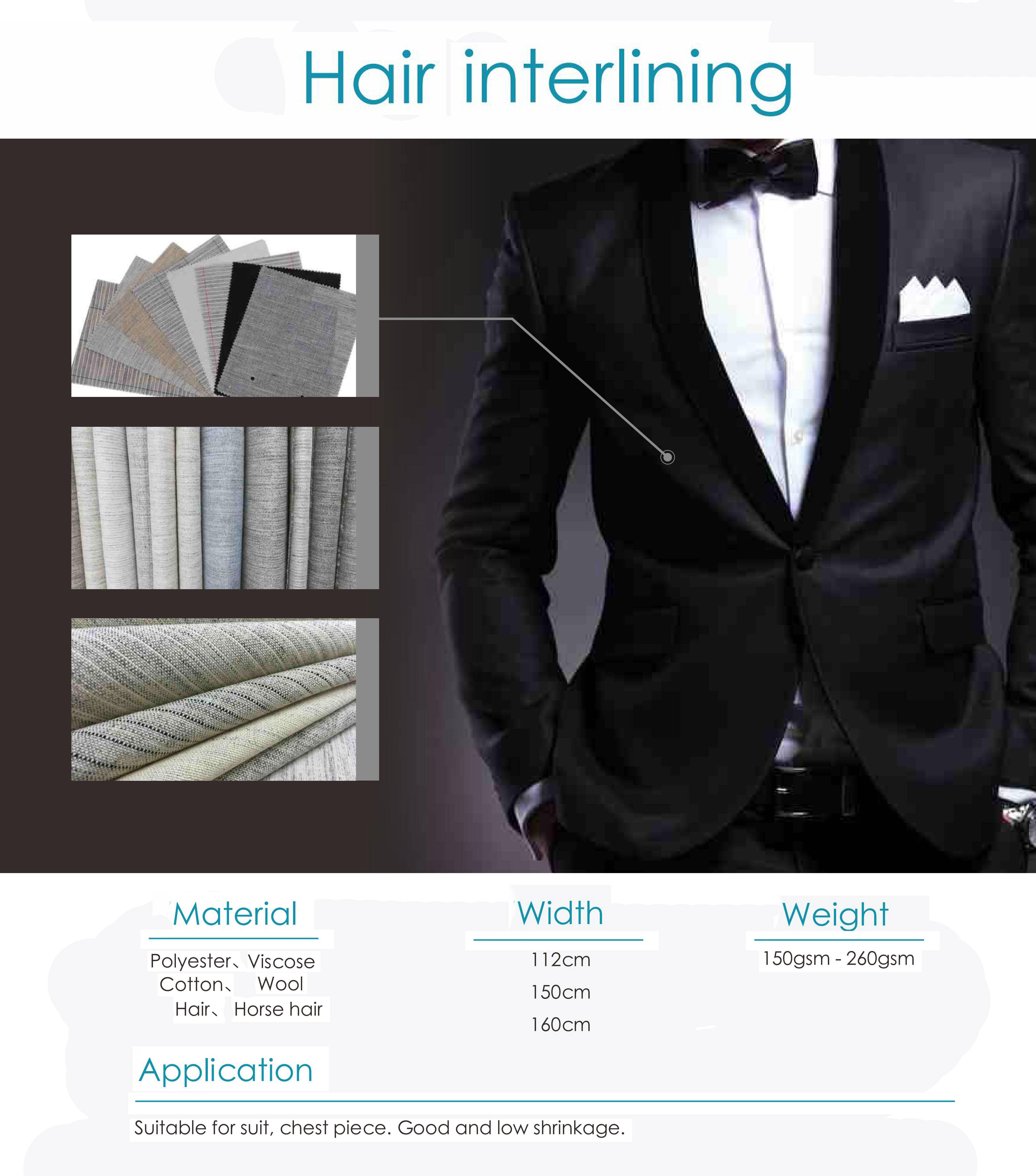Industry Trend Analysis of Hair Interlining
2024-10-15
Industry Trend Analysis of Hair Interlining
Hair interlining, is a premium interlining material used primarily in high-end garment manufacturing, particularly for suits, jackets, and formal wear. It is valued for its excellent structure, shape retention, and breathability, making it a staple in tailoring and luxury apparel. This article provides an in-depth analysis of the latest trends in the hair interlining industry, examining the factors driving its growth and its role in the evolving textile and fashion markets.
1. Rising Demand for Premium and Tailored Clothing
With increasing consumer demand for high-quality, bespoke garments, hair interlining is gaining popularity among manufacturers who specialize in premium clothing. As more consumers prioritize comfort, fit, and longevity in their apparel, luxury fashion brands are turning to high-performance interlining materials to deliver on these expectations.
- Trend: The resurgence of custom tailoring and made-to-measure suits is driving demand for hair interlining, particularly in regions like Europe and North America, where tailored clothing represents status and craftsmanship.
- Impact: This trend is expected to accelerate, as more consumers invest in durable, well-fitted garments that can maintain their structure and aesthetics over time, further boosting the demand for hair interlining.
2. Growth in the High-End Suit and Formal Wear Market
The global market for high-end suits and formal wear is expanding, particularly in developing economies such as China, India, and Southeast Asia, where growing disposable income and professional work environments are fueling demand for premium attire. Hair interlining, with its excellent structural support, is a key component in ensuring that these garments maintain their shape and drape.
- Trend: The increasing trend of corporate wear and luxury fashion in emerging markets has significantly impacted the demand for premium interlining materials like hair interlining.
- Impact: As more consumers in these regions purchase luxury suits and formal wear, manufacturers of hair interlining will see increased demand, particularly from tailors and fashion houses that cater to discerning customers.
3. Sustainability and Eco-Friendly Manufacturing
Sustainability is becoming a significant concern in the fashion industry, and hair interlining is benefiting from this shift. The material, often produced with a blend of natural fibers such as wool and hair, offers a more sustainable alternative compared to synthetic interlining options. Moreover, its durability reduces the need for frequent replacement, aligning with the growing trend of slow fashion and sustainable consumption.
- Trend: The demand for eco-friendly and biodegradable interlining materials is pushing manufacturers to focus on sustainable production methods for hair interlining, reducing the environmental impact of the garment manufacturing process.
- Impact: This shift toward sustainability is likely to drive innovation in the production of hair interlining, with a focus on natural fiber content and minimal waste generation, helping brands meet consumer and regulatory demands for greener products.
4. Technological Advancements in Manufacturing
Recent advancements in interlining manufacturing technologies have enhanced the performance characteristics of hair interlining. These innovations allow manufacturers to create lighter, more breathable, and thermally efficient interlining materials, which are essential for producing high-performance formal wear.
- Trend: The introduction of advanced techniques such as needle punching and high-precision weaving has improved the structural integrity and comfort of hair interlining, making it more suitable for contemporary garment designs.
- Impact: As technology continues to evolve, manufacturers can expect to see improvements in both production efficiency and the functional qualities of hair interlining, leading to wider adoption across different sectors of the fashion industry.
5. Customizable Solutions for Designers
Customization is becoming increasingly important for designers and manufacturers who seek to differentiate their products in a competitive market. Hair interlining offers a range of customization options, allowing designers to tailor the thickness, stiffness, and flexibility of the material to suit specific garment requirements. This versatility has made it a preferred choice for high-end designers who want to create unique, tailored garments.
- Trend: Fashion brands and garment makers are increasingly requesting bespoke interlining solutions to meet the specific needs of their collections, such as enhancing the structure of shoulder pads, lapels, and waistbands in luxury suits.
- Impact: The ability to customize hair interlining enhances its appeal to fashion houses and manufacturers seeking to create high-quality, tailored garments, further driving demand for the material.
6. Regional Market Dynamics
The hair interlining market is seeing significant growth across various regions, with Asia-Pacific, Europe, and North America emerging as key markets. The Asia-Pacific region, in particular, is experiencing rapid expansion due to its dominance in garment manufacturing and rising demand for luxury fashion. China, as a leading producer of hair interlining, plays a central role in meeting the global demand.
- Trend: The demand for hair interlining is increasing in China and South Korea, as these countries become major players in luxury fashion production, exporting high-end suits and formal wear to global markets.
- Impact: This regional growth is expected to drive further advancements in manufacturing techniques and distribution channels, ensuring a steady supply of high-quality hair interlining to meet the growing demand.
Conclusion
The hair interlining industry is poised for significant growth, driven by trends such as the rising demand for premium and tailored clothing, technological innovations, and the push toward sustainable manufacturing. As high-end fashion continues to evolve, hair interlining will remain a critical component in producing luxury garments that offer superior structure, comfort, and durability. With expanding market opportunities in regions such as Asia-Pacific and Europe, manufacturers are well-positioned to capitalize on these trends and meet the growing needs of both designers and consumers
https://www.uneed-tex.com/Product/info_itemid_123_lcid_29.html


 CN
CN